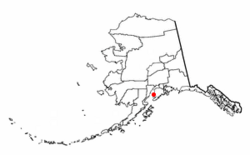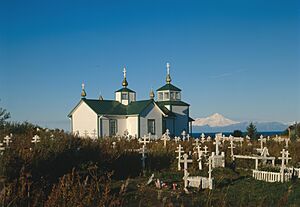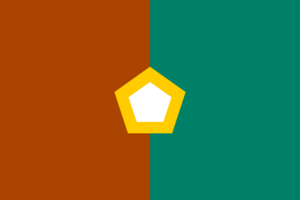Ninilchik, Alaska facts for kids
Quick facts for kids
Ninilchik
Нинильчик
Niqnalchint |
|
|---|---|

Ninilchik in 2010
|
|

Location of Ninilchik, Alaska
|
|
| Country | United States |
| State | Alaska |
| Borough | Kenai Peninsula |
| Area | |
| • Total | 207.27 sq mi (536.84 km2) |
| • Land | 207.25 sq mi (536.76 km2) |
| • Water | 0.03 sq mi (0.07 km2) |
| Elevation | 50 ft (20 m) |
| Population
(2020)
|
|
| • Total | 845 |
| • Density | 4.08/sq mi (1.57/km2) |
| Time zone | UTC-9 (Alaska (AKST)) |
| • Summer (DST) | UTC-8 (AKDT) |
| ZIP code |
99639
|
| Area code(s) | 907 |
| FIPS code | 02-54480 |
Ninilchik is a special kind of community in Alaska. It's called a census-designated place (CDP). This means it's a settled area that the U.S. Census Bureau defines for statistics. It's located in the Kenai Peninsula Borough.
The name Ninilchik comes from the Dena'ina word Niqnalchint. It also has a Russian name, Нинильчик. In 2020, about 845 people lived there.
Ninilchik is known as an Alaska Native village. This is because of a law called the Alaska Native Claims Settlement Act. In the 1970s, the people of Ninilchik created the Ninilchik Native Association Incorporated. Later, the Ninilchik Traditional Council (NTC) was formed. This council acts as the government for the Alaska Native people in the area.
Many people in Ninilchik have ancestors from different groups. These include Aleut and Alutiiq (Sugpiaq) people, as well as some Dena'ina. Some families also have Russian ancestors. These Russian ancestors first settled here in 1847. For nearly 200 years, a special Alaskan Russian language was spoken in the village. This unique dialect has been studied and preserved by experts.
Contents
Exploring Ninilchik's Location
Ninilchik is found on the western side of the Kenai Peninsula. It sits right on the coast of Cook Inlet. If you fly, it's about 38 miles southwest of Kenai. It's also about 100 miles southwest of Anchorage.
You can reach Ninilchik by road using the Sterling Highway. By car, it's about 188 miles from Anchorage. It's also 44 miles from Homer. The total land area of Ninilchik is about 207 square miles.
What's the Weather Like in Ninilchik?
Ninilchik has a cold climate, known as a continental subarctic climate. This means it has long, cold winters and short, cool summers.
| Climate data for Ninilchik, Alaska (1940-1968 normals and extremes) | |||||||||||||
|---|---|---|---|---|---|---|---|---|---|---|---|---|---|
| Month | Jan | Feb | Mar | Apr | May | Jun | Jul | Aug | Sep | Oct | Nov | Dec | Year |
| Record high °F (°C) | 45 (7) |
44 (7) |
46 (8) |
56 (13) |
68 (20) |
75 (24) |
74 (23) |
72 (22) |
66 (19) |
59 (15) |
47 (8) |
44 (7) |
75 (24) |
| Mean daily maximum °F (°C) | 24.4 (−4.2) |
30.7 (−0.7) |
29.7 (−1.3) |
40.3 (4.6) |
52.2 (11.2) |
62.2 (16.8) |
61.4 (16.3) |
61.5 (16.4) |
54.9 (12.7) |
42.6 (5.9) |
28.9 (−1.7) |
23.0 (−5.0) |
42.7 (5.9) |
| Daily mean °F (°C) | 17.6 (−8.0) |
23.0 (−5.0) |
19.5 (−6.9) |
32.2 (0.1) |
43.3 (6.3) |
51.3 (10.7) |
52.5 (11.4) |
52.0 (11.1) |
45.6 (7.6) |
33.4 (0.8) |
21.4 (−5.9) |
16.5 (−8.6) |
34.0 (1.1) |
| Mean daily minimum °F (°C) | 10.8 (−11.8) |
15.3 (−9.3) |
9.4 (−12.6) |
24.0 (−4.4) |
34.5 (1.4) |
40.3 (4.6) |
43.6 (6.4) |
42.5 (5.8) |
36.2 (2.3) |
24.2 (−4.3) |
13.8 (−10.1) |
10.1 (−12.2) |
25.4 (−3.7) |
| Record low °F (°C) | −20 (−29) |
−22 (−30) |
−33 (−36) |
0 (−18) |
22 (−6) |
29 (−2) |
26 (−3) |
33 (1) |
24 (−4) |
0 (−18) |
−12 (−24) |
−32 (−36) |
−33 (−36) |
| Average precipitation inches (mm) | 1.69 (43) |
1.28 (33) |
0.94 (24) |
1.50 (38) |
1.50 (38) |
1.22 (31) |
2.44 (62) |
3.41 (87) |
2.74 (70) |
2.68 (68) |
1.77 (45) |
2.07 (53) |
23.23 (590) |
| Average snowfall inches (cm) | 13.3 (34) |
8.8 (22) |
12.7 (32) |
10.0 (25) |
0.0 (0.0) |
0.0 (0.0) |
0.0 (0.0) |
0.0 (0.0) |
0.0 (0.0) |
2.6 (6.6) |
9.0 (23) |
22.8 (58) |
79.2 (201) |
| Average precipitation days (≥ 0.01 in) | 6 | 5 | 4 | 7 | 5 | 6 | 10 | 10 | 10 | 9 | 6 | 9 | 86 |
| Source: WRCC | |||||||||||||
Who Lives in Ninilchik?
| Historical population | |||
|---|---|---|---|
| Census | Pop. | %± | |
| 1880 | 53 | — | |
| 1890 | 81 | 52.8% | |
| 1920 | 87 | — | |
| 1930 | 124 | 42.5% | |
| 1940 | 132 | 6.5% | |
| 1950 | 97 | −26.5% | |
| 1960 | 169 | 74.2% | |
| 1970 | 134 | −20.7% | |
| 1980 | 341 | 154.5% | |
| 1990 | 456 | 33.7% | |
| 2000 | 772 | 69.3% | |
| 2010 | 883 | 14.4% | |
| 2020 | 845 | −4.3% | |
| U.S. Decennial Census | |||
Ninilchik first appeared on the U.S. Census in 1880. At that time, 53 "Creoles" lived there. These were people of mixed Russian and Native Alaskan heritage. By 2000, the population had grown to 772 people.
In 2000, most residents (82.25%) were White. About 13.99% were Native American. A small number were Asian or from other backgrounds. About 0.65% of the population was Hispanic or Latino.
The average household in Ninilchik had about 2.41 people. The median age was 42 years old. This means half the people were older than 42 and half were younger.
A Look Back at Ninilchik's History
Before Europeans arrived, Ninilchik was a hunting and fishing spot for the Dena'ina Athabaskan people. The name Ninilchik likely comes from a Dena'ina word meaning "lodge is built place."
Early Russian Settlement
The first Europeans to live permanently in Ninilchik were Russian colonists. They moved there from Kodiak Island in 1847. This was 20 years before the Alaska Purchase in 1867, when the United States bought Alaska.
One of the first settlers was Grigorii Kvasnikov (also known as Kvasnikoff). He came with his Russian-Alutiiq wife, Mavra Rastorguev, and their children. Soon after, the Oskolkoff family, also a Russian man and Alutiiq woman, joined them. These families and their descendants, who often married Alaska Natives, formed the core of the village.
The unique Russian dialect they spoke in the mid-1800s became the main language. It survived for a long time because the community was so isolated. Even in 2013, a few people still spoke this Ninilchik Russian dialect. Experts are now studying and recording this special language.
In 1880, the U.S. Census recorded 53 "Creoles" living in Ninilchik. These were descendants of the original Kvasnikoff and Oskolkoff families. They had many marriages with Alaska Natives, especially Alutiiq people.
In 1896, a school was built. Russian Orthodox priests and other church members taught there. These priests were respected by Alaska Natives. This was because they often learned local languages and held church services in those languages. In 1901, the local Russian Orthodox Church was rebuilt where it stands today.
The first school approved by the U.S. government opened in 1911. It was called the Ninilchik School. In 2011, the community celebrated the school's 100th anniversary.
Modern Developments
In the 1940s, more American settlers came to the area under the Homestead Act. In 1949, a company called Berman Packing Company started canning fish in Ninilchik. In 1950, the Sterling Highway was finished, making it easier to reach the town.
The Caribou Hills Fire
In 2007, a large fire called the Caribou Hills fire happened near Ninilchik. It moved towards the town and threatened about 300 buildings. The fire eventually burned almost 60,000 acres (about 243 square kilometers). It destroyed 197 buildings.
Alaska Native People in Ninilchik
The Alaska Native Claims Settlement Act officially recognized Ninilchik as an Alaska Native village. Because of this law, the villagers formed the Ninilchik Native Association Incorporated. The U.S. Congress also recognized the people of Ninilchik as having their own government. This is similar to American Indian tribes.
The Ninilchik Traditional Council (NTC) was given the power to govern. It serves the Native people who live in the Ninilchik area. It also serves those who are descendants of the original inhabitants.
Life in the Ninilchik Community
The original village of Ninilchik is located at the mouth of the Ninilchik River. A small harbor has been built there. Today, the name "Ninilchik" refers to both the old village and the larger community around it. This community stretches for several miles in different directions. People sometimes call the original settlement "Ninilchik Village" or just "the village."
Ninilchik is not an official city. It is part of the Kenai Peninsula Borough (KPB) and the State of Alaska. Volunteer groups, the NTC, the State of Alaska, and the KPB handle most government tasks. These include:
- Fire-fighting (done by volunteers)
- Highway snow removal (done by the state)
- Health services (provided by the NTC)
- Schools (managed by the KPB)
A Russian Orthodox church, the Holy Transfiguration of Our Lord Chapel, is also in the community.
Fun Things to Do in Ninilchik (Tourism)
Ninilchik is a popular place for tourists to visit. Many people come for salmon fishing. You can fish with commercial guides or with family businesses. Fishing happens along the beach north of the Ninilchik River or in Cook Inlet. Halibut can also be caught in Cook Inlet near Ninilchik.
Pacific razor clams are popular to dig for on the beaches. You can do this when the tides are very low. Always check local rules before digging for clams. Sometimes, clam fishing might be closed.
Ninilchik offers amazing views of four volcanoes in Cook Inlet. You can also see the historic Old Village and the famous Russian Orthodox church. The Ninilchik River and Deep Creek areas are beautiful. There's lots of wildlife and stunning beaches with bluffs. These spots offer great chances for taking photos.
Ninilchik hosts two big annual events:
- The Kenai Peninsula Fair
- The Salmonfest Alaska Music Festival (formerly Salmonstock)
The Ninilchik Chamber of Commerce also puts on the annual Clam Scramble. This is an obstacle run from river to river, usually held around the summer solstice.
Parks and Outdoor Areas
There are two Alaska State Parks in the Ninilchik area.
- Ninilchik State Recreation Area: This park is just north of town, at mile 135 on the Sterling Highway. It has two campgrounds and places to access the beach and river. You can also find scenic spots to view Cook Inlet.
- Deep Creek State Recreation Area: This park is south of Ninilchik. It has a large campground right on the beach. There are also parking areas for fishing in Deep Creek. You can even launch boats with help from tractors. Both parks are known for having many bald eagles around.
Famous People from Ninilchik
- Loren Leman: He is a politician who grew up in Ninilchik. He graduated from the Ninilchik School in 1968. Later, he became a civil engineer in Anchorage. He served in elected office from 1989 to 2006. He was also the lieutenant governor of Alaska. Loren Leman was the first person of Alaska Native heritage to be elected to a statewide office in Alaska.
See also
 In Spanish: Ninilchik (Alaska) para niños
In Spanish: Ninilchik (Alaska) para niños





